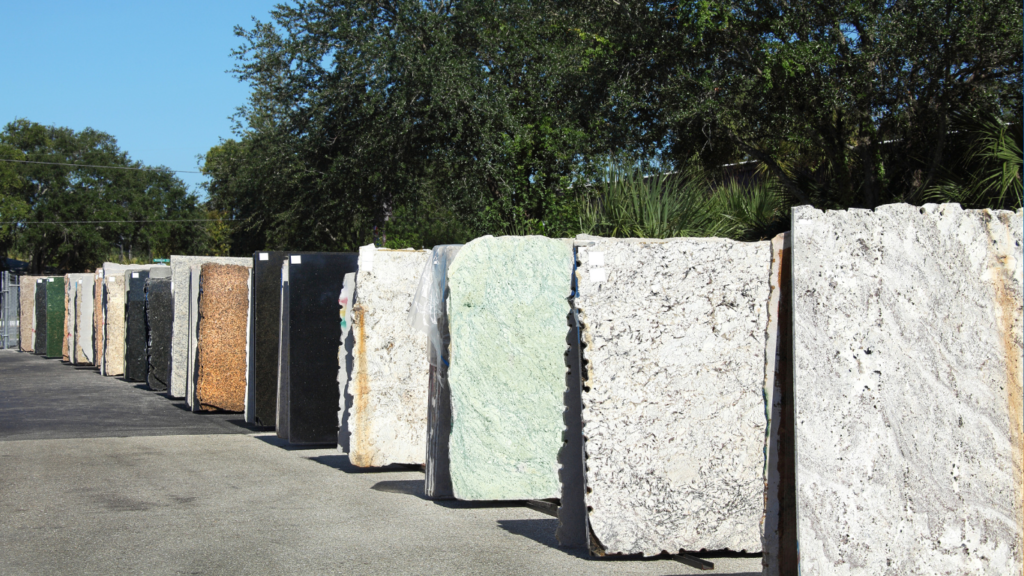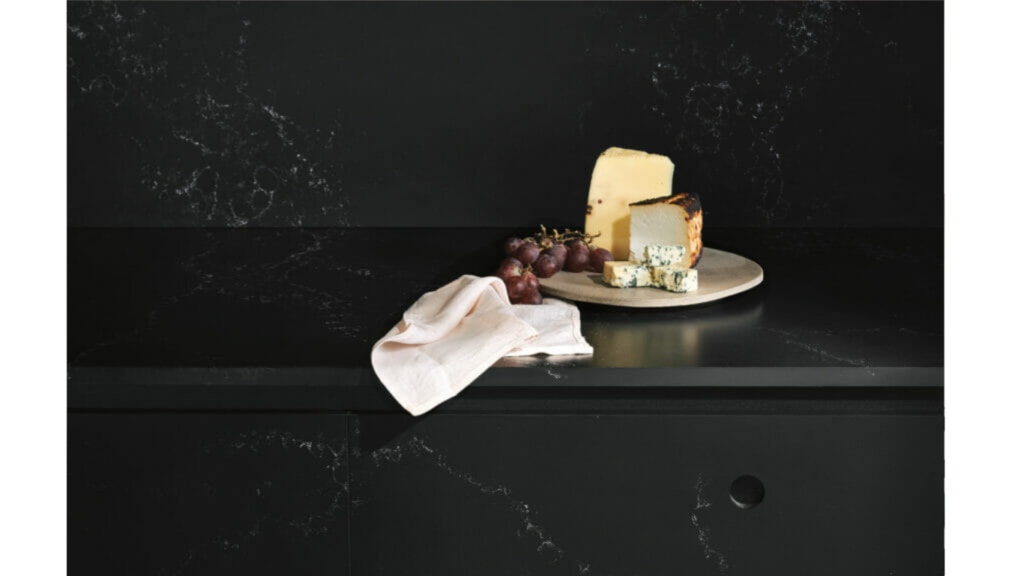Let’s explore the rich history and modern evolution of kitchen countertops. The journey takes us from the ancient quarries of Greece and Italy to today’s sleek, contemporary kitchens. In this article, The Brief History of Countertops, we delve into how these natural and engineered stones have become integral to our culinary spaces. You will discover the transformation of granite, Marble, and Quartz. They have transitioned from being symbols of architectural grandeur in ancient times to becoming the heart of our home kitchens.
The Ancient Foundations: Stone in Early Architecture
The use of natural stones in ancient architecture was not just for their structural integrity but also for their symbolic meanings. These materials were carefully chosen to reflect the time’s cultural, religious, and social ethos, leaving a legacy that continues to inspire modern architecture and design.
Early Uses of Natural Stone
Natural stone used in architecture traces its roots back to ancient civilizations. At that time, it was a structural cornerstone and a symbol of art and culture.
Marble in Greek and Indian Architecture:

Marble, renowned for its aesthetic beauty and durability, was a preferred material in ancient Greek architecture. The Parthenon in Greece, a testament to this, stands as a pinnacle of classical architecture. Its use of Pentelic Marble was not merely structural but also conveyed a sense of grandeur and reverence. Similarly, the Taj Mahal, an iconic symbol of love, was constructed in India using white Marble. This choice reflected the stone’s enduring beauty and its ability to intricately capture the artisanal craftsmanship of the Mughal architects.
Granite in Egyptian Structures:

In ancient Egypt, granite’s role extended beyond mere functionality to symbolize strength and eternity. The construction of monuments like the Great Pyramid of Giza. While the pyramid’s exterior was primarily limestone, the inner chambers were lined with granite, believed to protect the pharaoh’s sarcophagus. The ancient Egyptians also carved granite into obelisks, colossal structures that stood as symbols of divine sun rays, highlighting the stone’s enduring nature and the civilization’s advanced quarrying and sculpting techniques.
Granite and Marble in Ancient Times
Granite’s Endurance and Utility:
In ancient Egypt, granite symbolized permanence and strength. It was extensively used for constructing monumental buildings and as a material for statues of gods, pharaohs, and important figures, signifying its association with divinity and power.
Marble in Greek and Roman Architecture:
The Greeks initiated the extensive use of Marble, particularly white Marble from quarries like those on the island of Paros, to construct temples, statues, and public buildings. The Romans continued this tradition, using Marble for its aesthetic appeal and practical qualities such as durability and ease of carving. Marble became synonymous with Roman architecture, adorning buildings, baths, and forums across the empire.
Transition to Countertop Material: From Ancient Architecture to Modern Kitchens
Early Use in Homes
While stone has been a hallmark of monumental architecture since ancient times, its use within homes, especially as a functional and decorative surface, has a more recent history. Marble, revered for its aesthetic beauty and cool-to-the-touch surface, gradually found its way into domestic settings. This transition was spurred by its practicality for food preparation, particularly in warmer climates where its cool surface was ideal for tasks like rolling dough and preserving freshness.
Marble’s journey from grand architecture to household interiors reflects an appreciation for its elegance and a recognition of its practical qualities. Its use in homes was limited to countertops and extended to flooring, fireplaces, and other decorative elements. This utilization highlighted Marble’s versatility beyond just grand buildings and sculptures, underscoring its functional and aesthetic value in everyday life.
Granite’s Emergence in Homes
Granite’s trajectory into the domestic sphere, particularly as a countertop material, tells a story of evolving perceptions and uses. Renowned for its hardness and resistance to wear, granite’s initial uses were primarily in external structures due to its durability and strength. However, its aesthetic qualities and functional benefits gradually led to its adoption in home interiors.
In the late 19th century, granite began to be recognized as a viable material for countertops in homes, and this period marked the emergence of granite as more than just a structural stone but also a symbol of luxury and longevity in interior design. Initially, its use as a countertop material was limited to affluent households due to the cost of quarrying and processing the hard stone. The rarity and expense of granite countertops made them a coveted feature in upscale homes, reflecting both status and a taste for enduring materials.
Fabrication Technologies

Over time, advancements in quarrying and fabrication technologies made granite more accessible. This increased availability, coupled with its practical benefits, such as resistance to heat, scratches, and stains, propelled granite to become a popular choice for countertops in a broader range of homes. The shift from a luxury item to a more common feature in kitchens can be attributed to both technological advancements and changing consumer preferences, emphasizing the importance of durability and aesthetics in kitchen design.
Integrating natural stones like Marble and granite into home interiors, particularly in kitchens, reflects a broader trend of bringing elements of nature and timeless elegance into everyday living spaces. Using these stones in countertops has become a way to blend functionality with aesthetic appeal, creating practical and visually striking spaces. The enduring popularity of stone countertops continues to shape modern kitchen designs, offering a blend of historical richness and contemporary practicality.
Modern Kitchen Countertops: The Rise of Engineered Stone
Introduction of Engineered Stone in the 1960s
The landscape of kitchen countertops underwent a significant transformation with the introduction of engineered stone in the 1960s. This innovative material, epitomized by quartz countertops, marked a new era in kitchen design. Engineered stone is a composite material consisting of crushed stone. A binding agent, typically polymer resin, holds it together, although some newer variations employ a cement mix. The primary appeal of engineered stone is its remarkable ability to mimic natural stone while overcoming some of its limitations.
Characteristics and Fabrication of Quartz Countertops
Quartz countertops are a popular type of engineered stone that combines both the aesthetic qualities of natural stone and the functional benefits of modern technology. Creating quartz countertops involves mixing approximately 90-95% ground natural quartz with about 5-10% resins, polymers, and pigments. This mixture is poured into molds to form slabs, which can then be cut into countertops. The result is an incredibly durable, non-porous surface available in various colors and patterns. Unlike natural stone, Quartz does not require periodic sealing.
The Popularity Surge of Granite in the U.S.

In the United States, the 2000s witnessed a significant surge in the popularity of granite countertops. They were a luxury reserved for high-end kitchens. Granite became more accessible due to global supply chain improvements and advancements in quarrying and fabrication technologies. Granite countertops in American homes can be attributed to their unique natural beauty, durability, and the perceived value they add to a property. Each granite slab is unique, offering varied patterns and colors, which became desirable for homeowners seeking individuality in their kitchen aesthetics.
Quartz: A Rising Star in Countertop Choices
While granite dominated the countertop scene, Quartz began to emerge as a formidable competitor. The appeal of quartz countertops lies in their uniform appearance, which avoids the unpredictability of natural stone. Additionally, quartz countertops are known for their low maintenance requirements, resistance to stains and scratches, and a vast selection of colors and designs. This versatility allows homeowners to achieve a customized look that aligns with their personal style and kitchen decor.
Engineered Stone: A Sustainable and Versatile Option
Another factor contributing to the rise of engineered stone countertops like Quartz is their sustainability. Many quartz manufacturers incorporate recycled materials, reducing waste and appealing to environmentally conscious consumers. Moreover, the non-porous nature of the engineered stone makes it more hygienic, an important consideration for kitchen surfaces.
The Evolving Landscape in the History of Countertops
The evolution of kitchen countertops from natural stone to engineered options reflects broader home design and technology trends. Engineered stones offer practical benefits and customization that align with modern lifestyle needs. As kitchen design evolves, the choice between natural and engineered stone countertops will likely be influenced by a blend of aesthetic preferences, lifestyle requirements, and changing material technologies.
The Evolution of Kitchen Countertop Preferences: From Natural to Engineered Stones
Introduction to Changing Trends in Kitchen Countertops
The kitchen is often referred to as the heart of the home. There has been a significant evolution in design preferences, especially regarding countertop materials. This evolution reflects changes in aesthetics, functionality, and the broader societal values of sustainability and individual expression.
The Era of Natural Stone: Marble and Granite
Natural stones, e.g., Marble and granite, have been the epitome of luxury and elegance in kitchen countertops for many years. With its unique veining and classic beauty, Marble has been a symbol of sophistication. Granite is well known for its durability and diverse patterns. It became popular for its ability to withstand kitchen rigors while adding value to the home.
Granite: The Durable Classic
- Durability and Uniqueness: Granite’s main selling points are its durability and the unique patterns in each slab. It can resist heat, scratches, and stains, making it an ideal material for busy kitchens.
- Aesthetic Appeal and Value Addition: The natural beauty of granite, combined with its perceived value, has made it a sought-after material in home renovations and new constructions.
Marble: Timeless Elegance
- Aesthetic and Cooling Properties: Marble is popular for its timeless elegance and cool surface, making it ideal for baking and food preparation.
- Historical and Luxurious Appeal: Its use in ancient architecture has contributed to its association with luxury and sophistication in modern homes.
The Rise of Engineered Stone: Quartz Countertops

In contrast to natural stone, engineered stone, mainly Quartz, has risen in popularity due to several key factors.
Benefits of Quartz Countertops
- Customization and Consistency: Unlike natural stone, Quartz offers a more consistent and customizable appearance. It allows homeowners to tailor their countertops to specific design preferences.
- Low Maintenance: Quartz is non-porous, making it resistant to staining and eliminating the need for periodic sealing, unlike granite or Marble.
- Durability: Engineered to be robust and scratch-resistant, quartz countertops can withstand kitchen activities’ daily wear and tear.
Sustainability and Design Trends
Modern kitchen design trends strongly emphasize sustainability and personalized aesthetics, influencing the choice of countertop materials.
Eco-Friendly Options
- Use of Recycled Materials: Many quartz manufacturers now incorporate recycled glass, ceramics, and even reclaimed natural stone, reducing environmental impact.
- Sustainable Manufacturing Practices: Advances in manufacturing technologies have enabled more eco-friendly practices in producing natural and engineered stone countertops.
Design Innovations
- Technological Advancements: Cutting-edge technologies in stone processing have expanded the range of available designs, colors, and finishes, allowing for greater customization.
- Innovative Materials: Beyond traditional stone, materials like porcelain and sintered stone are gaining popularity for their durability and versatility in design.
A Reflection of Modern Values and Lifestyle
The evolution in kitchen countertop preferences from natural to engineered stones reflects contemporary values and lifestyles. Natural stones like granite and marble continue to be valued for their timeless beauty. Engineered stones like quartz’s practical benefits and customizable nature align more closely with modern demands for sustainability, low maintenance, and personalized design. As technology and societal values evolve, so will the materials we choose to embody the heart of our homes.
Conclusion: The History of Countertops and Ongoing Legacy
The journey of stone from ancient architectural marvels to modern kitchen countertops encapsulates a history of human ingenuity and aesthetics. Natural stones like marble and granite have been revered for centuries for their beauty and strength. In contrast, engineered stones like quartz represent modern times’ technological advancements and changing preferences. As technology and design preferences continue to evolve, the use of stone in kitchen countertops is likely to adapt, blending tradition with innovation.
Frequently Asked Questions about the History of Countertops
What is the origin of the countertop?
The term “countertop” evolved from using a counter (object) for counting purposes. In the 1800s, the term described any surface where transactions occurred, especially in supply stores.
What were older countertops made of?
Before industrialization, countertops were typically crafted from natural materials like wood and stone. Formica became popular in the 1960s.
What were countertops made of in 1910?
In the 1910s, tile countertops, including subway and hex tile, gained popularity. In the 1930s and ’40s, larger hex tiles were commonly used for both countertops and backsplashes.
What do the British call countertops?
The term “worktop” is commonly used in the United Kingdom, while “countertop” is the preferred term in the United States. Both describe the same functional surface.
Are Corian countertops outdated?
No, Corian countertops have evolved and come in various styles, some even mimicking the look of natural stone. They can be stylish and budget-friendly compared to pricier materials like marble or quartz.
